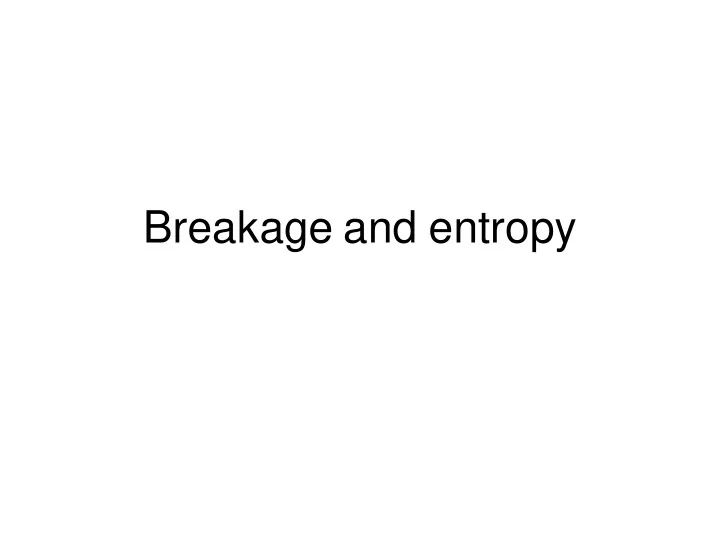

Breakage and entropy
Fractal distribution in nature Questions arisen from literature • Why fractal distribution is so frequent? • It is true that fractal dimension is always less than 3? • Is there an ultimate distribution? • Why fractal distribution with a fractal dimension of around 2.5 – 2.6 seems to be steady-state or stable?
Entropy notions • classical entropy of thermodynamics (S c ) (Clausius (1865)) • statistical formulation of the classical entropy of thermodynamics (S f ), • statistical entropy (S s ) • entropy of information theory (S I ) • grading entropy
Entropy principle The directional properties of natural or spontaneous processes (‘entropy principle’) : • In the classical sense, the second law of thermodynamics states: “In any closed system the entropy remains constant or increases during the ongoing processes “ (Breuer, 1993). • It is true that grading entropy can be related to the entropy principle?
• Basic assumption: Largest fraction does not disappear
Hard grains Sand samples: • One fraction sand • Concave fractal • Convex fractal • Silica, carbonate • Each sample was subjected to a series of crushing treatments using a special reinforced crushing pot, made at the Geotechnical Department with the dimensions: diameter: 50 mm, height: 70 mm, wall thickness: 3mm.
Oedometer pot • képek
The continuous grading curve path in the non- normalised diagram 2.8 N=7 Entropy increment, S [-] 2.8 N=7 Entropy increment, S [-] N=6 2.4 N=6 2.4 N=5 2.0 N=5 N=4 2.0 N=4 1.6 0.4 0.6 N=3 1.6 N=3 1.2 N=2 1.2 N=2 0.8 0.3 0.2 0.8 0.4 0.1 0.4 0.0 0.0 2.0 4.0 6.0 8.0 0.0 Base entropy, S [-] 0 0.0 2.0 4.0 6.0 8.0 Base entropy, S [-] 0
The discontinuous grading curve path in the normalised diagram 1.60 1.20 B [-] 0.80 0.40 continuous breakage path from dolomitic and silica sand data theoretical jump 0.00 0.00 0.20 0.40 0.60 0.80 1.00 A [-]
Initially one fraction soil n=105, n=125, n=85 Entropy increment, B [-] maximal entropy point for 1.2 6 fractions n=45 7 fractions n=65 0.8 n=1 0.4 n=0 0.0 A=2/3 0.6 0.8 1.0 Relative base entropy, A (-)
discontinuity jumps 1.2 (smaller fractions added) (larger fractions Initial B [-] 0.8 added) (N=2) (both smaller and larger fractions added) 0.4 N=3 N=3 4 N=4 0.0 0.0 0.2 0.4 0.6 0.8 1.0 A [-]
Comments on the normalized entropy path • Why fractal distribution is so frequent? • If N is constant, the path goes towards the maximum B line, where all grading curves have finite fractal distribution. • On the A >0.5 side of the maximum B line, the fractal dimension n varies between 3 and - infinity . • On the A< 0.5 side of the maximum normalized entropy increment line, the fractal dimension n varies between 3 and plus infinity .
Normalized 1: maximum entropy grading entropy diagram increment point where the stability rule fractal dimension is n =3 and fractal dimension independently of N. 1 a 2 3 4 5 Entropy increment, B [-] 2, 3, 4…7 : maximum I. 1.2 6 entropy points for N = 2, 3, II. 7 b 4…7 , the fractal dimension 0.8 c III. is n =2 since dependent on d e N except in point 1. f 0.4 I, II, III: Grain structure stability domains for N=7 0.0 0.6 0.8 1.0 I: piping, II: stable, III: Relative base entropy, A [-] stable with suffosion.
Some conclusions – hard grains • The base entropy S o decreases, the entropy increment Δ S strictly monotonically increases. The breakage speed is different for silica and carbonate sand, the path is similar. It is true that grading entropy can be related to the entropy principle? • It follows from the measured data that the entropy principle is valid for the Δ S entropy coordinate. • (The base entropy S o decrease can be explained by the decrease of the mean grain diameter during breakage.) •
• Why fractal distribution with n<3 is so frequent? If a smaller fraction appear, the normalized entropy path has a discontinuity, increasing the A value and decreasing B value. • As a result, the normalised entropy path is drifted into the right side of the diagram n <3, A>0.5. That is why the structurally stable grading curves (A>2/3 ) occur more frequently than the structurally unstable ones. • This can be used in rock testing.
• Is there an ultimate state? • Applying the entropy principle to the non-normalized grading entropy B , a theoretical ultimate state is resulted, the symmetry point of the maximum line, with fractal dimension n =3. • This can be reached by tests with topology change only (applied here) on condition that N stops to increase and large grains remain. • Further research is suggested on this and on soft rocks where the largest fraction does not remain.
Recommend
More recommend